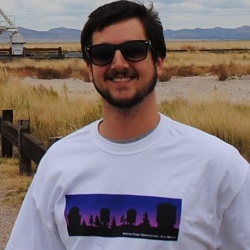I’m interested in finding and characterizing habitable extrasolar planets. Currently, I’m developing an atmospheric retrieval code to analyze the spectra of terrestrial exoplanets in the habitable zones of their parent stars with the hopes of determining which planets may be suitable for, or inhabited by, life.
About Me
My research focuses on characterizing the atmospheres of extrasolar planets. In particular, I am working with Dr. Victoria Meadows and the Virtual Planetary Laboratory to develop a framework for the retrieval of atmospheric and surface properties from small, potentially habitable exoplanets given both spectroscopic observations and known planetary science. Currently, however, no telescope crafted by humankind is capable of providing such observations as these objects are extremely small and extremely faint in comparison to their host stars. Thus in the meantime, I am working to motivate the design of future telescopes aimed specifically at alleviating these difficulties. In addition, I’m currently using observations of Solar System planets as a laboratory and testbed for my atmospheric retrieval code.
SMART Atmospheric Retrieval
Atmospheric retrieval is the process of teasing underlying atmospheric conditions from an observed planetary spectrum. It requires that two fundamental models talk to each other: a forward model containing the physics and an inverse model containing the statistics. My code leverages the Spectral Mapping Atmospheric Radiative Transfer (SMART) code to transform a set of atmospheric parameters into a high-resolution spectrum. The forward model then takes the SMART spectrum and degrades it to the quality of the observation using a telescope model. The inverse model brings it all together by iteratively running the forward model to determine the probability that the data are described by a specific choice of atmospheric parameters. This is Bayes’ Theorem in action. Thanks Bayes.
There’s a universe teeming with planets to explore. Welcome to the frontier.

